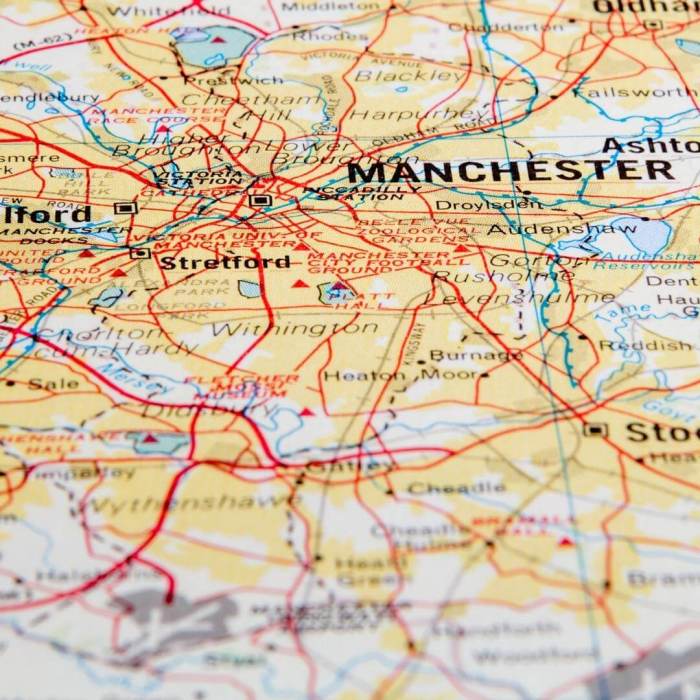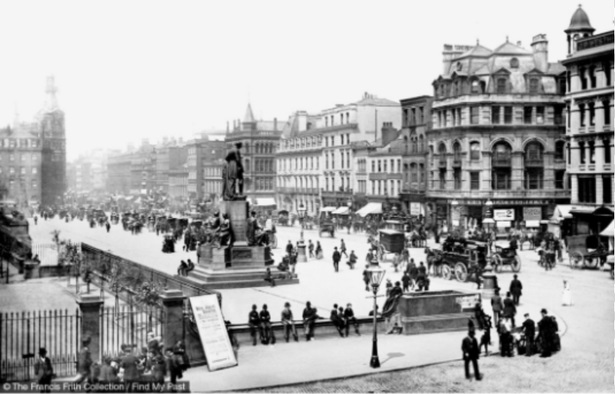
Our arrival in Manchester, UK, to live here was in late 2007. We settled here permanently in 2011 and haven’t left since!
The city has a rich history, but has changed significantly over the last 20 years.
It’s had a reputation for being a hive of working-class urban decay and poverty. That’s correct, in some respects, but there’s always been much more to the city centre than that. And we’re here to explore it today, thanks to the wonder of modern tech.
Video Footage of Manchester Through the Years (1901-1970s)
Manchester was a hotbed of industrial activity for much of the 19th century, which passed over into the 20th.
Later in the century, it gained a reputation for being cultural… but rough and ready (argy-bargy etc.) The late ’80s Madchester music scene, featuring nightclubs like the Haçienda, was summed up in the 2001’s biopic 24 Hour Party People.
And these days Manchester is now one of the UK’s leading economic hotbeds, rapidly rising up after serious regeneration over the last 20 years. That followed on from an IRA bomb in June 1996, which demolished a huge chunk of the city centre.
It’s now one of the trendiest places you can live in the UK and continues to grow as a rampant metropolis.
This does seem to be to the disappointment of some of the older generations we’ve talked to about it, who preferred the relative peace and quiet, and the less advanced, Manchester of old. Let’s take a look at it.
Manchester in the 1970s
Looking at Piccadilly Gardens here, we can confirm the layout of the city centre has barely changed over the last 50 years.
All those main buildings? Still there. And still looking pretty much exactly the same.
If this was New York, they’d have been bulldozed to the ground and replaced with something fancier. We don’t really have the budget for that here.
Several films were also shot in, and around, the city. There was The Lovers!, a 1973 film directed by Herbert Wise.
It starred Richard Beckinsale (yes, the father of famous actors Samantha and Kata Beckinsale) and Paula Wilcox. The film is set in 1972 and is about the dating life of Northern cheeky chappies. Here’s the trailer.
Richard Beckinsale also starred as Lennie Godber in the BBC sitcom Porridge. Unfortunately, he died suddenly in March 1979 of heart failure. He was only 31.
In 1974, there was an extended scene in the centre filmed for the Spanish-Italian horror film Let Sleeping Corpses Lie.
Other footage shows off the city’s nightlife, which seemed to be rather restaurant heavy back in t’ good old days.
For most of this footage, there are YouTube comments with people reminiscing happily.
Some complain everything is too “posh” these days and they preferred it in the past. The occasional right-winger is also there doing the ubiquitous whining about diversity and how “no one speaks English no more”.
Bollocks. Everyone in Manchester speaks English. The city these days is more multicultural than ever—and all the better for it.
Manchester in the 1960s
The above footage is quite remarkable. Again, it confirms Piccadilly Gardens just hasn’t changed that much. Exactly the same layout as now.
It also confirms Manchester at night is a great place to be when you’re right in the heart of the city centre.
You usually get a great sunset and the hustle and bustle, the city murmur, is much more pleasant to deal with than in, say, London.
One thing that does surprise us is the abundance of traffic.
Yeah, city centre and all that. But we always just figured there weren’t that many cars around in the ’60s. We were pretty wrong on that.
https://www.youtube.com/watch?v=FffjzZGFcJ0&ab_channel=TonyP
Cult classic Withnail & I (1987) springs to mind here, when the hapless duo make a fateful trip from London to Penrith in a knackered out Jaguar.
The iconic buses are all over the place. Naturally. That’s a feature to this day (although they’re no longer red). You can’t bloody move for buses in England.
That’s probably quite unusual for Americans to think of, as they’re so reliant on their personal cars to get around.
But in England, a super small country, everything is interconnected by constant public transport. Mainly buses.
Manchester During World War II
Although London took most of the brunt during the Blitz of 1940 and 1941, Manchester was not immune.
One of the most notable bombings was on the Metropolitan-Vickers works in Manchester, which was demolished after being struck by 12 long tons of bombs.
In total, 578 tons of bombs landed in and around the city. For comparison, Liverpool faced 1,957 tons and London 18,291.
Manchester in the 1930s
Okay, apparently the department store in the background is a Woolworths.
We’re pretty sure this location is right in Manchester city centre at Piccadilly Gardens. That’d make the road Oldham Street. These days, that shop is now a Morrisons supermarket.
It’s also a no-go zone still for road users, only public transport is allowed through there. No trams go through there bit, but about 37 million buses an hour do.
Seriously, if you like buses go and hang around Piccadilly Gardens. You can see buses and someone will try to sell you drugs, too.
There’s also this footage of some students larking about on a rowing boat. This was part of their post-studying celebrations.
Further proof, if ever it were needed, that the WORLD is GOING to the DOGS. Kids these days… so unruly. They don’t know they’re born!
How DARE they have fun. They need some personal responsibility!
Seriously, though, it’s nice to see the youths of the day having a laugh. See, it wasn’t stuffy boredom back then? You got to throw stuff at your mates!
Manchester in 1901
The above is possibly the earliest ever recorded footage from Manchester. It’s also updated with modern technology into colour below.
It’s of Corporation Street, which is actually right where we live now. Seriously, we could leave our flat now and be there in five minutes. Neat, eh?
We believe these were filmed by the company Mitchell and Kenyon,
who were pioneers of early commercials. They were based in Blackburn of Lancashire.
Along with recording street scenes (which would have been radical, back in 1901), they produced small productions about the Boer War (1899-1902).
Much of the footage was lost until 1994, when a big hoard of films was discovered and restored. That’s now called the Mitchell & Kenyon Collection.
And Finally… Manchester’s Piccadilly Gardens in the 19th Century

There it is! Piccadilly Gardens in 1889. To the left of this picture (where the gate is) there was a large domed building.
Apparently, this was an infirmary. It occupies where the main bit of Piccadilly Gardens now is—these days, a grassy area with several fountains and numerous restaurant chains.
We’ve taken a quote here from the Francis Firth Collection to highlight what happened to the domed building (i.e. the doomed building).
“The dome of the Infirmary is on the left, and Lewis’s tower is in the centre. On Tuesday 1 September 1908, a large crowd gathered here to watch about one hundred patients being moved out of the Infirmary. Horse-drawn ambulances, taxi cabs, flat wagons, and even a horse bus were used to convey the patients down to the new Royal Infirmary on Oxford Road. Only one patient was left behind because he was too ill to move. The main buildings were soon demolished, but the Wash House remained, as did part of the Asylum, which was used as a reference library before the Central Library was built.”
The Manchester Evening News covered many of these in see Manchester through the eyes of your ancestors. Plenty more pictures there.
The pictures were by Francis Firth (1822-1898), an English photographer.
He ran a photograph studio in Liverpool from 1850 onward, whilst also working as a grocer, painter, and photographer. He was a founder of the Liverpool Photographic Society in 1853. He sold his companies in 1855 to focus on his photography interest.
He helped create an extensive record of early Manchester photographs, many of which were the first ever to be taken off the city.

It did disturb me a little to read of the demolishment of the main buildings barely one sentence after your assurance of the continued presence of (only) a single soul therein… It wasn’t HIS fault he was too sick to move! Shame on that demolition company. 😱
LikeLiked by 1 person
I presume they shifted the final dude out of there… but then it was 1889 and social attitudes were a tad different back then. Hopefully, he at least got some fish, chips, and mushy peas for tea.
It’s actually weird, thinking now, there was an asylum RIGHT in the city centre at its very beating heart. It’s just fountains and grass now (plus drug dealers – don’t forget the drug dealers).
LikeLike
Ha, just TRY to forget the drug dealers! Do so at your peril! If it’s a choice between drug dealers and mushy peas, ALWAYS choose the… just a second, I really have to think about this one…
LikeLike
I generally try to avoid the drug deals, yes, I think what you’re aiming for there is “choose the mushy peas”.
LikeLike
Oh, no, not even for a moment.
Okay, well, then, it depends on what kind of drugs they have… 🤣🙄
LikeLike
You name it, they deal it. Tic Tacs, Jaffa Cakes, BBQ sauce. It can get nasty.
LikeLike
The BBQ sauce has infiltrated even Northwest England, eh? Ooh, things are getting very dicey in our world…
LikeLike
Yeah, it’s not so popular here. We’re more into ketchup, which is American I believe. It rains too often here to have constant BBQs, anyway.
LikeLike
Ooh, I’ve heard ketchup is even MORE addictive than the Sauce… Not that I’ve ever touched any myself, you understand.
BTW, you don’t know where to get any, do you?…
LikeLike
Ketchup? Sure, find your nearest store. Acquire a vehicle. Then proceed to ramraid the store, grab the ketchup, and run.
LikeLike
Yeah, just don’t get caught. Last I checked, the sentencing enhancement for ketchup was a hefty one…
LikeLike
I’m sticking with houmous! It’s too deeply ingrained in my brain these days and I’m ruddy obstinate about it. Speaking (or typing) of houmous, I just had a big bunch right now.
LikeLike
Not even a-SHAMED ~ brazen garbanzo bean lover!
LikeLike
I love very old footage showing life in big cities. This was a blast to watch and read.
LikeLiked by 1 person
Glad you enjoyed! Manchester’s history is pretty vast, but fish, chips, and mushy peas have never been far away!
LikeLiked by 1 person
I love the Mitchell and Kenyon films.
LikeLiked by 1 person
They are very impressive! Real pioneers at work, there.
LikeLiked by 1 person